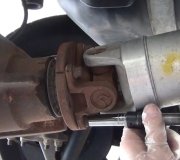First consider that while it should not be necessary, we always try to mark the shafts so they go back together the same way. If one piece is rotated 180 degrees relative to the others, it can set up a vibration, but if that actually does occur, it's usually at higher speeds.
Every professional has ended up with a tight u-joint at some point in their career, and that can cause a low-speed vibration where the joint's bearing cups have more time to momentarily stop rotating. If you recall one new joint not being able to rotate freely, give them a sharp rap with a hammer on the loop of the drive shaft. That often snaps the cap a little and will let them spin easier.
Of course if you had trouble installing one of the caps, most likely one of the needle bearings fell over. Normally you won't be able to force it together without blowing the end of the cup out, but I've heard people talk about finding that with the end of the cap just bowed out and not actually broken.
The biggest thing to consider is sagged suspension, especially due to the age of the truck. Every tire and alignment shop will have a small book that lists every vehicle, where to take the measurements, and what they should be. Weak springs that allow a vehicle to sit as little as an inch lower than specs can set up a drive line vibration due to the incorrect drive shaft angle relative to the tail shaft in the transmission and the pinion gear in the differential. If your truck has a lift kit or lowering kit, you're on your own. No suspension and alignment specialist would ever destroy their vehicle that way because we know all about the safety and legal ramifications.
Ford has always had a real big problem with ride height. Anything that uses the twin I-beam suspension is susceptible to very poor tire wear, and that is even worse on the skinny Ranger and Bronco 2. Their older full-size conversion vans from the '80s developed a drive line vibration in as little as six months. That was solved by installing stiffer rear springs.
GM's main problems are with their full-size trucks and vans. They always have a characteristic vibration that all owners become used to, but sagged suspension will aggravate that. That is not normal on their smaller trucks.
Don't overlook a balancing weight that go knocked off during the recent service. Normally you would expect that to show up at higher speeds, but in reality, there is often a specific speed RANGE where the vibration is more noticeable. That range is dependent on the diameter, length, and weight of the out-of-balanced section of the shaft.
You might also check at the dealer to see if there is a different drive shaft design for your truck. There were a few Dodges in the mid '90s that developed a drive line vibration after a few years, and the fix was to replace the two-piece drive shaft with a one-piece shaft. That solved the problem, but it came back a few years later. Then, the fix was to go back to the two-piece shaft. Go figure!
If your truck uses front torsion bar suspension, look at the cross member under the seats where those bars are attached. On GMs, those cross members are attached to the frame rails through mounts with rubber isolators, and those often tear loose. The common complaint is a knocking noise or thumping feeling over bumps. That's not a safety concern, but you don't want to overlook that when looking for the cause of a vibration. Anything with forces acting on it that is not held solidly can set up or amplify a vibration.
One last thing is to loosen the mounting bolts for the carrier bearing and let it center itself. It must not be off-center from where it is designed to be located, and it can't be twisted. Also check for a torn rubber isolator in that assembly.
Tuesday, January 13th, 2015 AT 8:58 PM


